Abstract
The records of 59 children with craniopharyngioma first treated between 1960 and 1980 were reviewed. There was a high incidence of postoperative growth hormone deficiency (43 of 43), andrenocorticortopin deficiency (26 of 36), thyrotrophin deficiency (13 of 20), gonadotrophin deficiency (15 of 16), and diabetes insipidus (44 of 58). Fifteen patients have died: diabetes insipidus was a contributory factor in 5 patients who died within the first 4 months of surgery; and 8 further children died unexpectedly after the postoperative period, probably as a result of anterior pituitary insufficiency. In addition, hypopituitarism led to medical emergencies in 12, 9 of whom had symptomatic hypoglycaemia. These findings illustrate the high incidence of pituitary deficits which follow current methods for treating childhood craniopharyngioma, and the long-term risks associated with these deficits.
Full text
PDF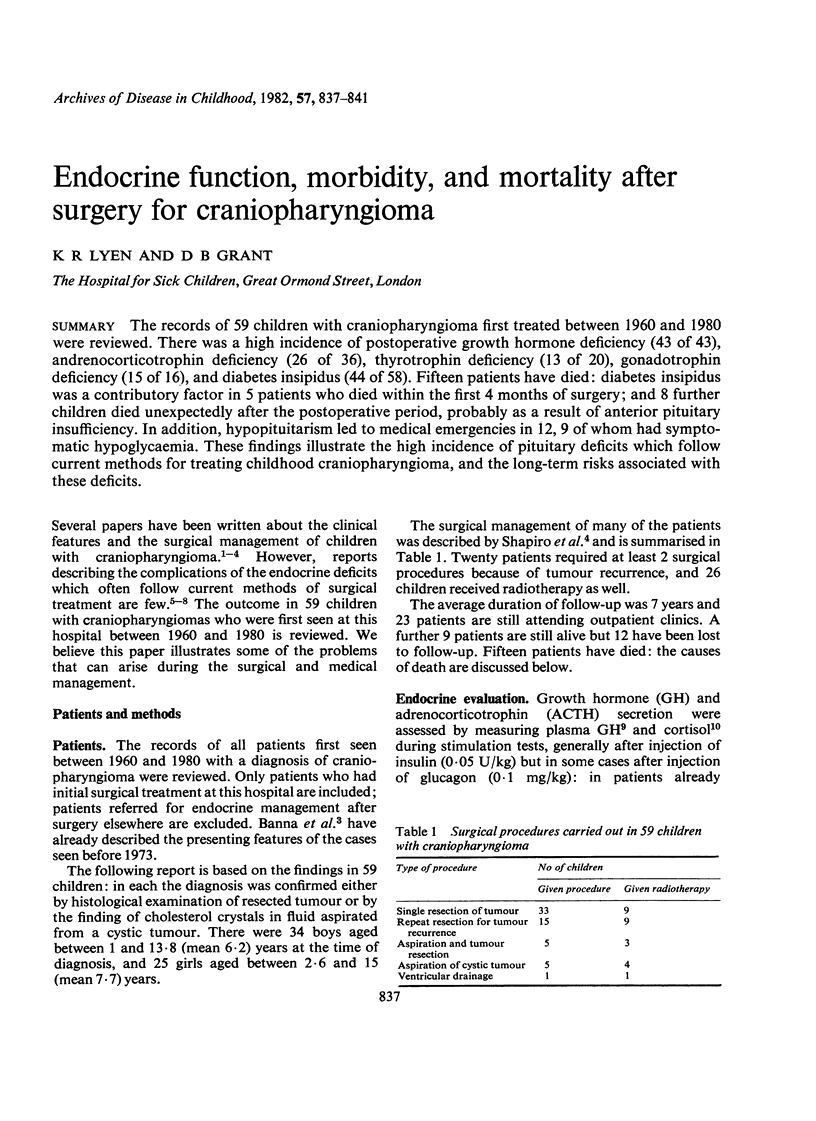
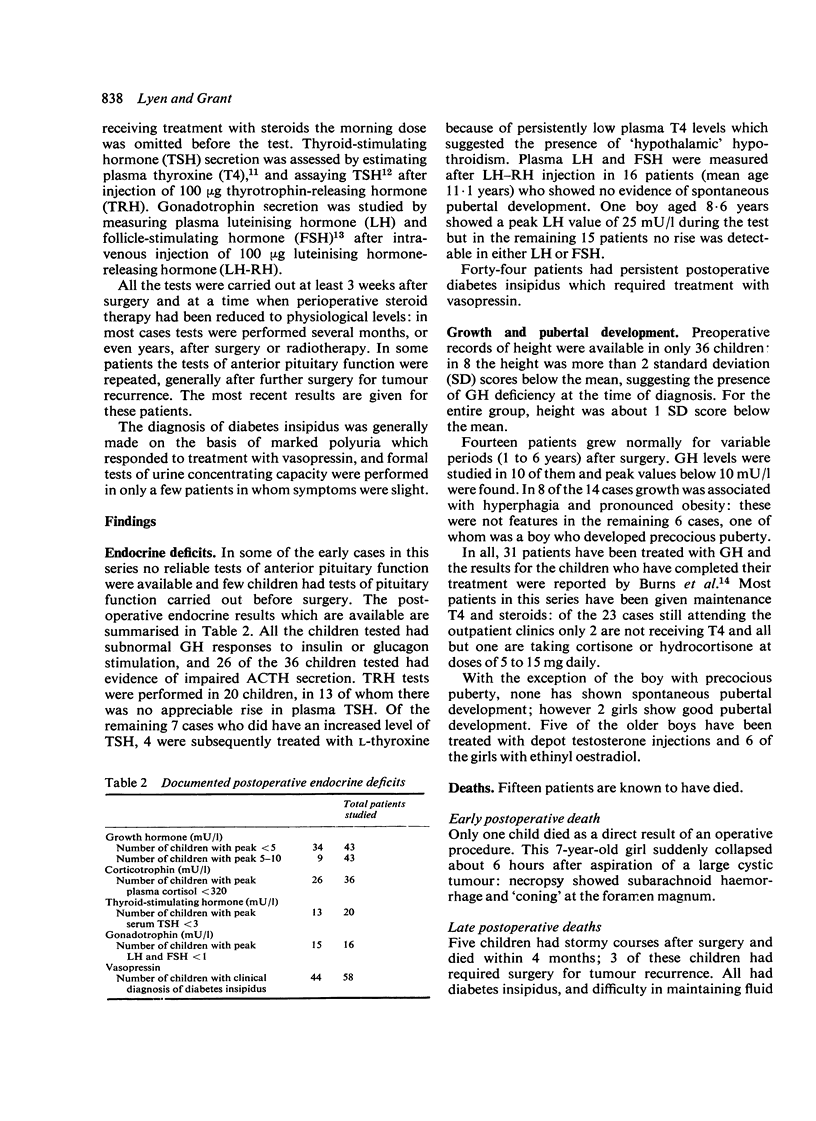
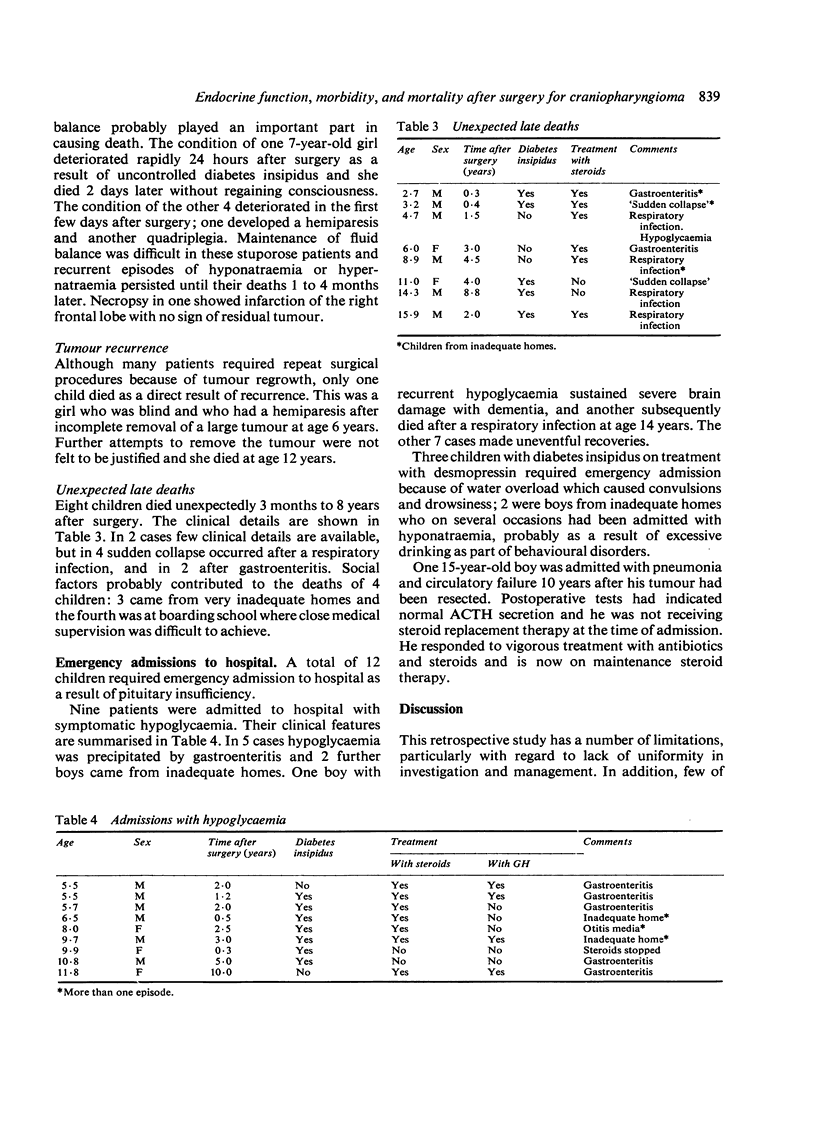
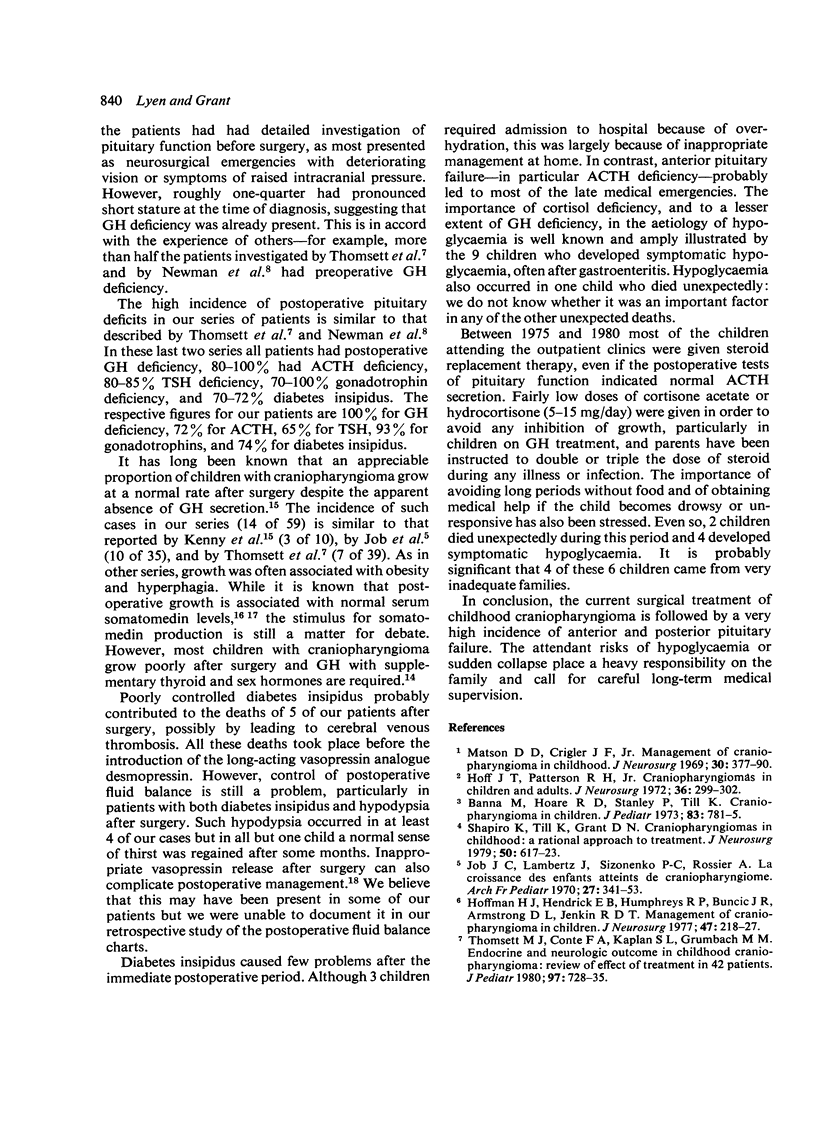
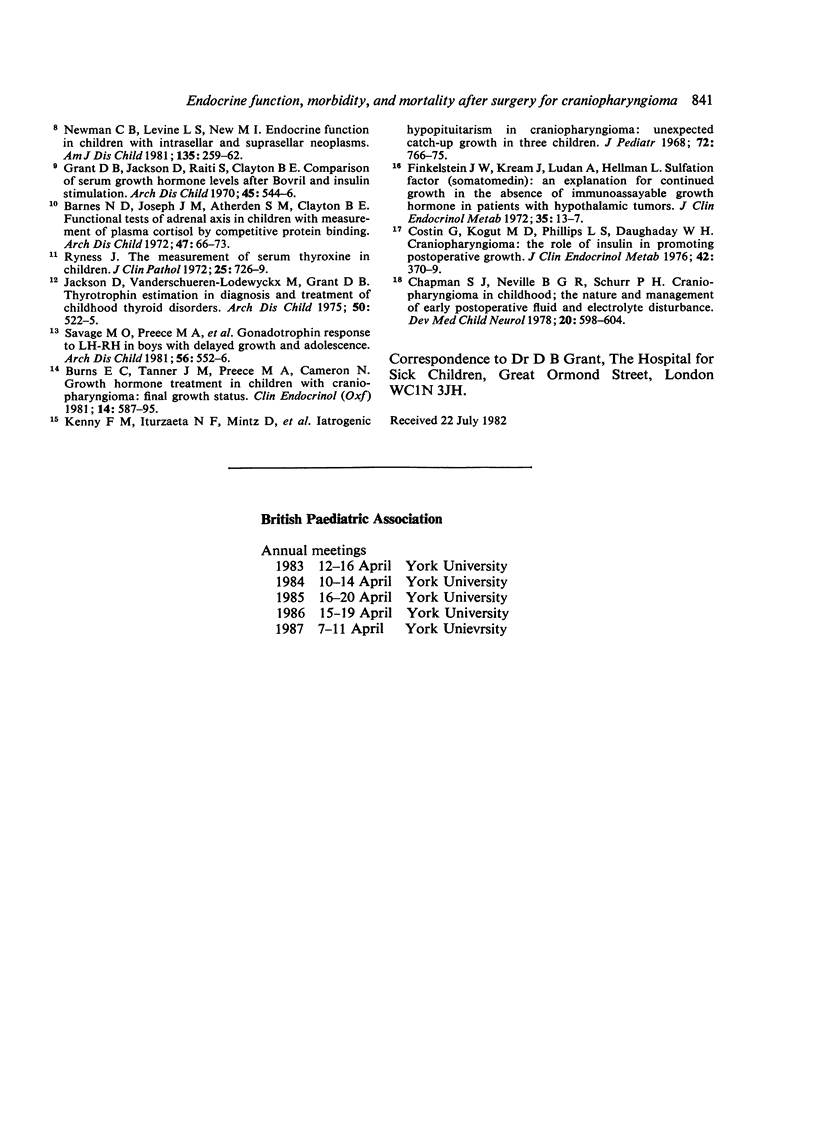
Selected References
These references are in PubMed. This may not be the complete list of references from this article.
- Banna M., Hoare R. D., Stanley P., Till K. Craniopharyngioma in children. J Pediatr. 1973 Nov;83(5):781–785. doi: 10.1016/s0022-3476(73)80369-5. [DOI] [PubMed] [Google Scholar]
- Barnes N. D., Joseph J. M., Atherden S. M., Clayton B. E. Functional tests of adrenal axis in children with measurement of plasma cortisol by competitive protein binding. Arch Dis Child. 1972 Feb;47(251):66–73. doi: 10.1136/adc.47.251.66. [DOI] [PMC free article] [PubMed] [Google Scholar]
- Burns E. C., Tanner J. M., Preece M. A., Cameron N. Growth hormone treatment in children with craniopharyngioma: final growth status. Clin Endocrinol (Oxf) 1981 Jun;14(6):587–595. doi: 10.1111/j.1365-2265.1981.tb02969.x. [DOI] [PubMed] [Google Scholar]
- Chapman S. J., Neville B. G., Schurr P. H. Craniopharyngioma in childhood: the nature and management of early postoperative fluid and electrolyte disturbance. Dev Med Child Neurol. 1978 Oct;20(5):598–604. doi: 10.1111/j.1469-8749.1978.tb15278.x. [DOI] [PubMed] [Google Scholar]
- Costin G., Kogut M. D., Phillips L. S., Daughaday W. H. Craniopharyngioma: the role of insulin in promoting postoperative growth. J Clin Endocrinol Metab. 1976 Feb;42(2):370–379. doi: 10.1210/jcem-42-2-370. [DOI] [PubMed] [Google Scholar]
- Finkelstein J. W., Kream J., Ludan A., Hellman L. Sulfation factor (somatomedin): an explanation for continued growth in the absence of immunoassayable growth hormone in patients with hypothalamic tumors. J Clin Endocrinol Metab. 1972 Jul;35(1):13–17. doi: 10.1210/jcem-35-1-13. [DOI] [PubMed] [Google Scholar]
- Grant D. B., Jackson D., Raiti S., Clayton B. E. Comparison of serum growth hormone levels after Bovril and insulin stimulation. Arch Dis Child. 1970 Aug;45(242):544–546. doi: 10.1136/adc.45.242.544. [DOI] [PMC free article] [PubMed] [Google Scholar]
- Hoff J. T., Patterson R. H., Jr Craniopharyngiomas in children and adults. J Neurosurg. 1972 Mar;36(3):299–302. doi: 10.3171/jns.1972.36.3.0299. [DOI] [PubMed] [Google Scholar]
- Hoffman H. J., Hendrick E. B., Humphreys R. P., Buncic J. R., Armstrong D. L., Jenkin R. D. Management of craniopharyngioma in children. J Neurosurg. 1977 Aug;47(2):218–227. doi: 10.3171/jns.1977.47.2.0218. [DOI] [PubMed] [Google Scholar]
- Jackson D., Vanderschueren-Lodeweyckx M., Grant D. B. Thyrotrophin estimation in diagnosis and treatment of childhood thyroid disorders. Arch Dis Child. 1975 Jul;50(7):522–525. doi: 10.1136/adc.50.7.522. [DOI] [PMC free article] [PubMed] [Google Scholar]
- Kenny F. M., Iturzaeta N. F., Mintz D., Drash A., Garces L. Y., Susen A., Askari H. A. Iatrogenic hypopituitarism in craniopharyngioma: unexplained catch-up growth in three children. J Pediatr. 1968 Jun;72(6):766–775. doi: 10.1016/s0022-3476(68)80428-7. [DOI] [PubMed] [Google Scholar]
- Matson D. D., Crigler J. F., Jr Management of craniopharyngioma in childhood. J Neurosurg. 1969 Apr;30(4):377–390. doi: 10.3171/jns.1969.30.4.0377. [DOI] [PubMed] [Google Scholar]
- Newman C. B., Levine L. S., New M. I. Endocrine function in children with intrasellar and suprasellar neoplasms: before and after therapy. Am J Dis Child. 1981 Mar;135(3):259–266. doi: 10.1001/archpedi.1981.02130270051017. [DOI] [PubMed] [Google Scholar]
- Ryness J. The measurement of serum thyroxine in children. J Clin Pathol. 1972 Aug;25(8):726–729. doi: 10.1136/jcp.25.8.726. [DOI] [PMC free article] [PubMed] [Google Scholar]
- Savage M. O., Preece M. A., Cameron N., Jones J., Theintz G., Penfold J. L., Tanner J. M. Gonadotrophin response to LH-RH in boys with delayed growth and adolescence. Arch Dis Child. 1981 Jul;56(7):552–556. doi: 10.1136/adc.56.7.552. [DOI] [PMC free article] [PubMed] [Google Scholar]
- Shapiro K., Till K., Grant D. N. Craniopharyngiomas in childhood. A rational approach to treatment. J Neurosurg. 1979 May;50(5):617–623. doi: 10.3171/jns.1979.50.5.0617. [DOI] [PubMed] [Google Scholar]
- Thomsett M. J., Conte F. A., Kaplan S. L., Grumbach M. M. Endocrine and neurologic outcome in childhood craniopharyngioma: Review of effect of treatment in 42 patients. J Pediatr. 1980 Nov;97(5):728–735. doi: 10.1016/s0022-3476(80)80254-x. [DOI] [PubMed] [Google Scholar]


